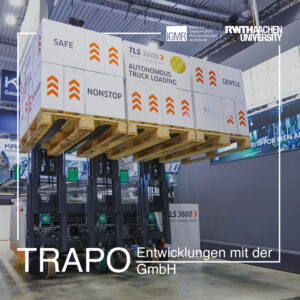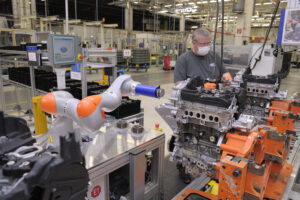Kategorie: ‘Allgemein’
Robot Cooking – Transferring observations into a planning language
Transferring observations into a planning language: An automated approach in the field of cooking
In the Robot Cooking project, an automated method is developed to analyze and identify motion data and convert it into a machine-readable planning language. This is done using a cooking scenario as an example in which the motion data is captured by recording the hand pose of the cook.
The recording is done using a motion capture system consisting of seven cameras and a glove with three markers on the back of the chef’s hand. The position of the markers is determined by triangulation. This provides enough information to derive the hand pose. The recording is done at 120 frames per second. Before the cooking process, all objects in the workspace are identified and their initial positions determined. Motion data is continuously recorded and converted into poses with time stamps. Additional information such as velocity, acceleration and angle in relation to the tabletop are derived from the raw data.
A initial structure of the dataset is created by finding the side actions using classification. Here, pick, move and place are identified as recurrent side actions. A separate training dataset is used to train a classifier that recognizes these actions. This enables an easier analysis of the remaining actions.
Clustering is applied to identify unknown actions. A dynamic approach allows analysis despite high variability in execution. A unique fingerprint for each action is found, based on the orientation of the back of the hand and its speed on the table plane, to assign each frame to a cluster and finally to an action.
The knowledge gained from classification and clustering is translated into a machine-readable Planning Domain Definition Language (PDDL). A schedule is created, with known actions directly assigned. Start and end positions are specified, and virtual object tracking is used to represent the progression of objects during cooking. For unknown actions, preconditions and effects are handled dynamically. The results are translated into a machine-readable PDDL. This formal representation enables efficient automatic scheduling and execution of the previously demonstrated cooking task.
Additional information is available in the video linked above, the poster and the paper.
Contact:
Markus Schmitz
Situational adaptive movement prediction for firefighting squads in indoor attack

We presented our paper “Situational Adaptive Motion Prediction for Firefighting Squads in Indoor Search and Rescue” at ICRA in the Long-Term Human Motion Prediction workshop.
Firefighting is a complex but poorly automated task. To minimize ergonomic and safety risks for firefighters, robots could be used in a collaborative approach. To enable human-robot teams in firefighting, important fundamentals are still missing. Among other things, the robot must predict human movement because occlusions are ubiquitous. In this work, we propose a novel motion prediction method for firefighting squads in indoor attack. Squad paths are generated using an optimal graph-based planning approach that represents firefighter tactics. Paths are generated on a per-room basis, allowing dynamic local adaptation of paths without global replanning. The movement of individual agents is simulated using a modification of the Headed Social Force Model. We evaluate the feasibility of the pipeline using a novel dataset generated from real footage and show its computational efficiency.
Contact: Elodie Hüsing
Developments with Trapo GmbH

The IGMR – RWTH Aachen supports Trapo GmbH in the further development and integration of trajectory planning and trajectory execution algorithms for the new Trapo Loading System robot. Compared to the old TLS, the navigation of the new TLS is realized with the MoveBase Framework of the Robot Operating System (ROS). For this purpose, together with Trapo GmbH, we have created a special configuration for car-like structure for the local MoveBase Planner. The new TLS was last presented at the LogiMat trade fair.
Contact:
Daniel Gossen
Project launch IIDEA – Inclusion and integration through cobots on the labor market

In April, the innovative project “IIDEA – Inclusion and integration through cobots in the first labor market” was launched, which aims to empower the inclusion and integration of severely disabled people in the first labor market through collaborative robotics.
The deployment of cobots makes it possible to create new jobs and forms of work that satisfy the individual needs of severely disabled people. These new forms of work are not being established on the margins but at the heart of digitization and Industry 4.0.
In a rapidly changing world, we must focus on the needs of all people and ensure that everyone can reach their full potential. The IIDEA project is an important step towards an inclusive and inclusive society and economy.
For more information about the project, please visit the project profile. If you have any further questions, please feel free to contact our staff: iidea@igmr.rwth-aachen.de.
Contacts:
Prof. Mathias Hüsing
Carlo Weidemann
Sophie-Charlotte Keunecke
Elodie Hüsing
Christina Jansen
Automatic Robot-Guided Form Scan and Coating
In this project, the forms are detected and their edges are realized by a laser scanner mounted on the end effector of the robot. The collected data are synchronized and filtered, and a suitable trajectory is created for coating the inner surface of the forms. Several variables, such as the speed of the nozzle, distances and gaps, the size of the nozzle and the outlier for a homogeneous coating can be selected during the trajectory planning.
Motivation
The project was initiated with the motivation to increase flexibility in scanning and coating various molds.
Method
In the context of this project, synchronization is required between three systems
The sensor software, which is responsible for the acquisition of the data (synchronized with movement of the robot).
The program, which is responsible for post-processing the data and calculating the trajectories for the robot.
The Robot control system, which receives the information of the trajectory and executes it immediately.
Partner
International Partners in Glass Research (IPGR) e.V.
Contact: Markus Schmitz
Watch the video on our Youtube Channel: here.
Music: Corbyn Kites – Blurry Vision
The IGMR visits the Automatica in Munich

After a long, involuntary break, IGMR was able to visit Automatica in Munich for the first time again. Together Jan Wiartalla, Amir Shahidi and Sophie Charlotte Keunecke explored various innovations and presentations and had many interesting conversations. In addition, some final year students of RWTH and IGMR presented their extremely interesting projects at Automatica and offered an exclusive view even beyond the exhibited possibilities.
On the last day of the fair, June 24. 2022, Sophie Charlotte Keunecke represented IGMR at a panel discussion on “Automation and robotics: what drives the new generation?” at the Automatica Forum. You can find the video here on the Youtube channel of Automatica.
Contacts:
Sophie Charlotte Keunecke
Jan Wiartalla
Transformation of workplaces by human-robot collaboration (HRC) at Ford
Since April 2021, employees with disabilities have been working successfully with a collaborative robot at the production line of Ford engine plant in cologne. The robot takes over the unergonomic pressing of the VCT solenoids into the engine cover and the employee installs the screws. During this process, humans and robots work simultaneously in the same workspace. The key findings and results of the project are summarized in the strategy paper.
Further information on the project can be found here.
Contact:
How construction site robots work on a wall
The in-house developed robot has 7 degrees of freedom, which are realized exclusively via revolute joints. Due to the redundancy, the robot can also develop its full performance in narrow situations such as corridors or niches. The video on the left shows a vertical trajectory in which the robot works on a wall from the floor to a height of 2.50m. The video on the right shows the horizontal trajectory of a wall immediately in front of the robot.
More information about this project can be found on the IGMR Website.
Contact person:
Lösungen der Praktischen Übungen in Robotic Systems
Auch in diesem Jahr haben uns wieder kreative Lösungen für Problemstellungen aus dem Modul Robotic Systems erreicht. Die Studierenden konnten erste Erfahrungen bei der Programmierung eines Fanuc Roboters in Roboguide sammeln. Eine Umfangreiche Programmieraufgabe galt es weiterhin an der Fanuc Education Cell zu lösen. Auf Grund der Einschränkungen der Präsenzveranstaltungen mussten alle Lösungen virtuell in Roboguide gelöst werden. Im nächsten Winter wird dann wieder am realen Roboter erprobt.
Ansprechpartner:
Herzlich Willkommen am IGMR!
Der an dieser Stelle eingebundene Inhalt führt Sie auf Seiten, die von der von Google betriebenen Seite YouTube - YouTube, LLC, 901 Cherry Ave., San Bruno, CA 94066, USA - zur Verfügung gestellt werden. Mit dem Aufruf des Inhalts kann YouTube Ihre IP-Adresse und die Sprache des Systems, sowie verschiedene browserspezifische Angaben ermitteln. Wenn Sie in Ihrem YouTube-Account eingeloggt sind, ermöglichen Sie YouTube, Ihr Surfverhalten direkt Ihrem persönlichen Profil zuzuordnen. Dies können Sie verhindern, indem Sie sich aus Ihrem YouTube-Account ausloggen. YouTube verwendet Cookies und Tracking-Tools. Die Datenverarbeitungsvorgänge sowie die Zwecke der Verarbeitung können direkt bei YouTube erfragt und eingesehen werden.




